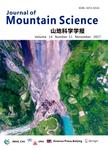Land cover change and carbon stores in a tropical montane cloud forest in the Sierra Madre Oriental,Mexico
Land cover change and carbon stores in a tropical montane cloud forest in the Sierra Madre Oriental, Mexico作者机构:Center for Biological ResearchAutonomous University of Hidalgo.42184 HidalgoMexico Institute oJ:Ag ricultural SciencesAcademic Area of Forestry EngineeringAutonomous University of Hidalgo.43600 HidalgoMexico Postgraduate SchoolCampus MontecilloPostgraduate in Forest Sciences.56230 Estado de MexicoMexico
出 版 物:《Journal of Mountain Science》 (山地科学学报(英文))
年 卷 期:2018年第15卷第10期
页 面:2136-2147页
核心收录:
学科分类:09[农学] 0903[农学-农业资源与环境]
基 金:support with doctorate fellowship CONACy T(No.266708) Postgraduate Sciences in Biodiversity and Conservation of the Center for Biological Research,UAEH
主 题:Cloud forest Carbon stores C mitigation Climate change Dinamica EGO Forest management Remote sensing.
摘 要:Tropical montane cloud forest is one of the ecosystems with the highest biomass worldwide, representing an important carbon store. Globally its deforestation index is –1.1%, but in Mexico it is higher than –3%. Carbon estimates are scarce globally, particularly in Mexico. The objective of this study was to simulate future land-cover scenarios for the Sierra Madre Oriental in Mexico, by analyzing past forest cover changes. Another objective was to estimate stored carbon in the two study areas. These objectives involve the generation of information that could be useful inputs to anti-deforestation public policy such as the REDD+ strategy. Remote sensing was used to measure land cover change and estimate carbon stocks. Satellite images from 2015, 2000 and 1986 were used, and Dinamica EGO freeware generatedmodels of future projections. Between 1986 and 2015, 5171 ha of forest were converted to pasture. The annual deforestation rates were –1.5% for Tlanchinol and –1.3% for the San Bartolo Tutotepec sites. Distance to roads and marginalization were highly correlated with deforestation. By 2030, an estimated 3608 ha of forest in these sites will have been converted to pasture. Stored carbon was estimated at 16.35 Mg C ha-1 for the Tlanchinol site and 12.7 Mg C ha-1 for the San Bartolo site. In the Sierra Madre Oriental deforestation due to land cover change(–1.4%) is higher than levels reported worldwide. Besides having high values of stored carbon(14.5 Mg C ha-1), these forests have high biodiversity. The models outputs show that the deforestation process will continue if action is not taken to avoid the expansion of livestock pasturing. This can be done by paying incentives for forest conservation to the owners of the land. The results suggest that REDD+ is currently the most viable strategy for reducing deforestation rates in tropical montane cloud forests in Sierra Madre Oriental.



